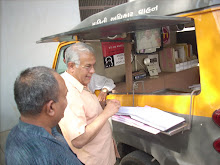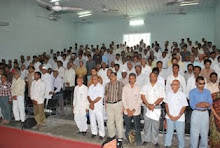Hindustan Times: Satya Prakash:Sunday,28 August, 2011.
As Justice Soumitra Sen of the Calcutta High Court faces impeachment proceedings, the focus is back on corruption in the Indian judiciary, often accused of opposing measures to introduce transparency and accountability in an institution that also judges the works of the Legislature and the Executive.
During the debate on the resolution in the Rajya Sabha to remove Justice Sen, cutting across party lines, MPs attacked the judiciary for corruption, lack of accountability and the collegium system of appointments, in which the executive hardly has any role to play. No wonder, in his farewell speech, Justice VS Sirpurkar of the Supreme Court described the statements against the judiciary as “indigestible”.
Should the Judiciary be under Lokpal ?:
Gandhian Anna Hazare, who had been on an indefinite fast since August 16 to demand a strong Lokpal (anti-corruption ombudsman), first demanded that the judiciary be brought under the Lokpal. However, team Anna is now said to have agreed to keep the judiciary out of the purview of the Lokpal if the government simultaneously brings the Judicial Standards and Accountability Bill with strong provisions to deal with judicial corruption.
Gandhian Anna Hazare, who had been on an indefinite fast since August 16 to demand a strong Lokpal (anti-corruption ombudsman), first demanded that the judiciary be brought under the Lokpal. However, team Anna is now said to have agreed to keep the judiciary out of the purview of the Lokpal if the government simultaneously brings the Judicial Standards and Accountability Bill with strong provisions to deal with judicial corruption.
“Judiciary can’t be covered by this (proposed) Lokpal. It should be covered by another alternative mechanism. We call it the National Judicial Commission,” leader of Opposition in the Rajya Sabha Arun Jaitley said on August 18, during the debate on Sen’s impeachment.
According to former Chief Justice of India PN Bhagwati, bringing the judiciary under the Lokpal would “seriously” affect its independence. Only a “specialised agency” should be entrusted to ensure accountability in the judiciary, whose autonomy could be compromised if brought under the Lokpal, Bhagwati said in an open letter to Hazare.
According to former Chief Justice of India PN Bhagwati, bringing the judiciary under the Lokpal would “seriously” affect its independence. Only a “specialised agency” should be entrusted to ensure accountability in the judiciary, whose autonomy could be compromised if brought under the Lokpal, Bhagwati said in an open letter to Hazare.
The Judicial Standards and Accountability Bill, 2010:
The UPA government introduced the Judicial Standards and Accountability Bill in the Lok Sabha on December 1, 2010. It proposes to lay down judicial standards, provide for the accountability of judges, and requires them to declare their assets and liabilities, and also that of their spouse and children.
The UPA government introduced the Judicial Standards and Accountability Bill in the Lok Sabha on December 1, 2010. It proposes to lay down judicial standards, provide for the accountability of judges, and requires them to declare their assets and liabilities, and also that of their spouse and children.
The Bill requires judges to practise universally accepted values of judicial life, such as prohibition on close association with individual members of the Bar who practise in the same court as the judge and allowing family members who are members of the Bar to use the judge’s residence for professional work.
Law Commission Vice Chairman KTS Tulsi terms it a historic step, saying, “For the first time judges’ conduct is being defined by a statute.”
The proposed law is to replace the Judges (Inquiry) Act, 1968 that lays down procedure for removal of the Supreme Court and high court judges. But most importantly, it empowers the common man to file complaints against judges of the high courts and the Supreme Court.
The proposed law is to replace the Judges (Inquiry) Act, 1968 that lays down procedure for removal of the Supreme Court and high court judges. But most importantly, it empowers the common man to file complaints against judges of the high courts and the Supreme Court.
The numbers game:
Under the present system provided for in the Judges (Inquiry) Act, 1968, the process for removal of a judge can be initiated through a resolution either by 100 Lok Sabha members or 50 Rajya Sabha members.
Under the present system provided for in the Judges (Inquiry) Act, 1968, the process for removal of a judge can be initiated through a resolution either by 100 Lok Sabha members or 50 Rajya Sabha members.
After the MPs submit a duly signed motion to the Lok Sabha speaker or Rajya Sabha Chairman, the presiding officer constitutes a three-member committee to probe the allegations and determine if it is a fit case for initiating the impeachment process.
If the panel indicts the judge, the resolution for removal has to be passed by two-thirds majority in both Houses in the same session. The resolution is then sent to the President, who orders removal of the judge. The judge is given an opportunity to defend him/her.
While retaining the reference procedure, the Bill proposes to introduce a complaint procedure to empower the aam admi to file complaints against judges of the high courts and the Supreme Court.
While retaining the reference procedure, the Bill proposes to introduce a complaint procedure to empower the aam admi to file complaints against judges of the high courts and the Supreme Court.
It seeks to establish two authorities a National Judicial Oversight Committee and a Scrutiny Panel to investigate complaints against judges.
The Oversight Committee will comprise a retired Chief Justice of India as the chairperson, a judge of the Supreme Court nominated by the sitting Chief Justice of India, a Chief Justice of the High Court, the Attorney General for India, and an eminent person appointed by the President. The scrutiny panel shall comprise a former Chief Justice and two sitting judges of that court.
A Parliamentary panel on Law and justice is said to have recommended inclusion of one MP each from the Lok Sabha and the Rajya Sabha in the Oversight Committee. Initial complaints will be made to the Oversight Committee, and they will be referred to the scrutiny panel constituted in the Supreme Court and in every High Court.
If the scrutiny panel feels there are sufficient grounds for proceeding against the judge, it shall report on its findings to the Oversight Committee.
When the panel finds that the complaint is frivolous, or that there not sufficient grounds for inquiring against into the complaint, it shall submit a report to the Oversight Committee giving its findings for not proceeding with the complaint.
If the scrutiny panel recommends investigation into a complaint against a judge, the Oversight Committee will constitute an investigation committee to probe into the complaint. The probe panel will comprise three members. It will frame definite charges against the judge and shall communicate the same to the judge, who shall be given an opportunity to present the case, but if the judge chooses not to be heard, the proceedings may be heard without him present.
The Removal of a judge:
If the Oversight Committee feels that the charges proved against the judge merit his/her removal, it shall request the judge to resign voluntarily, and if the judge fails to do so, it shall advise the president to proceed with the removal of the judge. In such a case, the President shall refer the matter to Parliament, where the rest of the procedure is the same as the one in the case of a motion moved by MPs.
If the Oversight Committee feels that the charges proved against the judge merit his/her removal, it shall request the judge to resign voluntarily, and if the judge fails to do so, it shall advise the president to proceed with the removal of the judge. In such a case, the President shall refer the matter to Parliament, where the rest of the procedure is the same as the one in the case of a motion moved by MPs.
The Bill exempts documents and records of proceedings related to a complaint from the purview of the RTI Act, 2005 but the reports of the investigation committee and the order of the Oversight Committee can be made public. The tainted judges gallery
Why The Collegium stays:
Under Article 124(2) and Article 217(1) of the Constitution, a judge of Supreme Court/High Court has to be appointed by the President after “consultation” with the Chief Justice of India (CJI). The government was not bound by the CJI’s recommendation.
But in 1993, the Supreme Court introduced the collegium system, taking over primacy in appointments to higher judiciary. A nine-judge Constitution Bench in 1998 ruled that “consultation” must be effective and the chief justice’s
opinion shall have primacy. Now India is the only nation in the world where judges appoint judges. In 2008, the Law Commission favoured restoration of pre-1993 position. Despite the UPA government criticising the collegium system, the Bill does not propose to change it.
Under Article 124(2) and Article 217(1) of the Constitution, a judge of Supreme Court/High Court has to be appointed by the President after “consultation” with the Chief Justice of India (CJI). The government was not bound by the CJI’s recommendation.
But in 1993, the Supreme Court introduced the collegium system, taking over primacy in appointments to higher judiciary. A nine-judge Constitution Bench in 1998 ruled that “consultation” must be effective and the chief justice’s
opinion shall have primacy. Now India is the only nation in the world where judges appoint judges. In 2008, the Law Commission favoured restoration of pre-1993 position. Despite the UPA government criticising the collegium system, the Bill does not propose to change it.
Post-retirement carrots:
During his speech on Sen’s impeachment, Jaitley said: “The desire of a job after retirement is now becoming a serious threat to judicial independence.”
During his speech on Sen’s impeachment, Jaitley said: “The desire of a job after retirement is now becoming a serious threat to judicial independence.”
Tulsi also described it as a menace. “I agree with Jaitley that judges should not be given post-retirement jobs. If a statute requires a judicial person, a sitting judge can be appointed.”
The way forward:
Prevention is better than cure. What is needed is a system that ensures only an honest person becomes a judge. If that happens, the occasion for removal of a judge may not arise. Also, the collegium system must go, says former law minister Ram Jethmalani. “Setting up a National Judicial Commission is the only solution. The Commission must have the powers to appoint, transfer and remove judges,” he said.
He, however, said: “It should be a broad-based body comprising a government representative, the leader of the opposition and representatives of the judiciary, organised Bar, academic world and the world of social sciences.”
Prevention is better than cure. What is needed is a system that ensures only an honest person becomes a judge. If that happens, the occasion for removal of a judge may not arise. Also, the collegium system must go, says former law minister Ram Jethmalani. “Setting up a National Judicial Commission is the only solution. The Commission must have the powers to appoint, transfer and remove judges,” he said.
He, however, said: “It should be a broad-based body comprising a government representative, the leader of the opposition and representatives of the judiciary, organised Bar, academic world and the world of social sciences.”
















































































